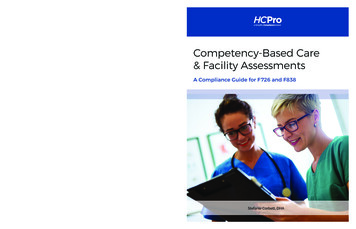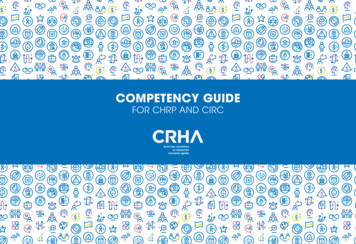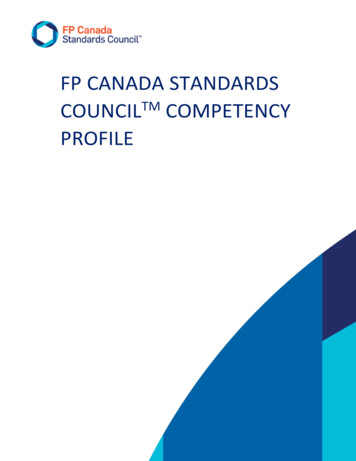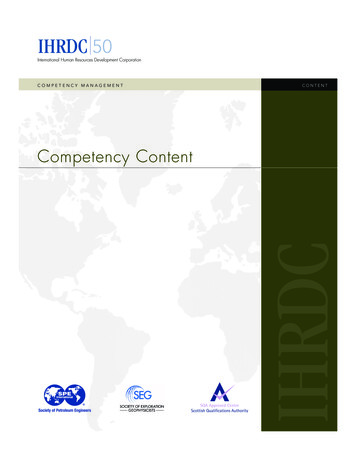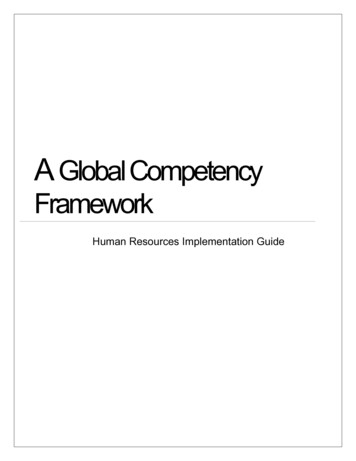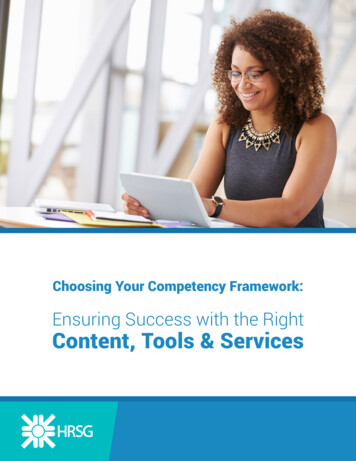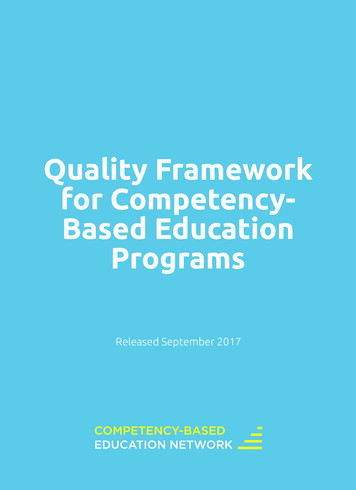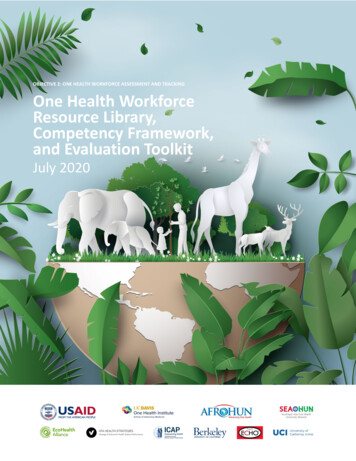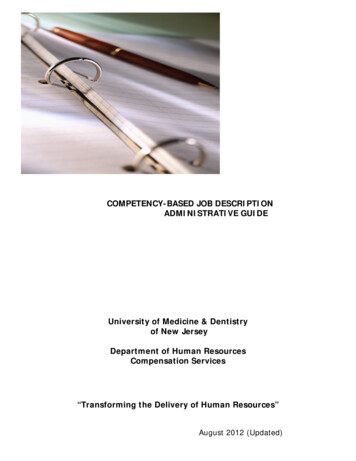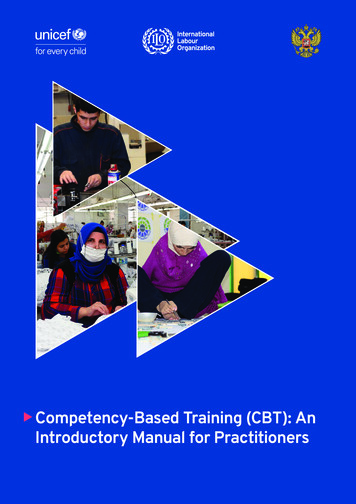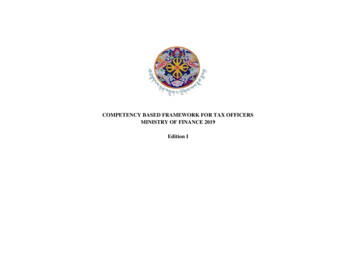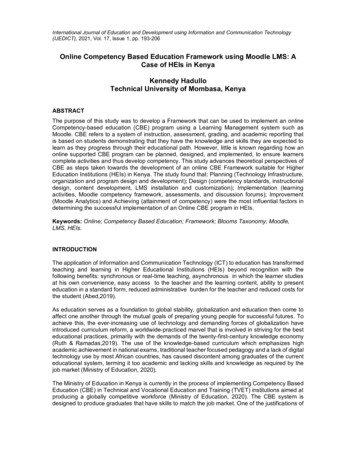
Transcription
International Journal of Education and Development using Information and Communication Technology(IJEDICT), 2021, Vol. 17, Issue 1, pp. 193-206Online Competency Based Education Framework using Moodle LMS: ACase of HEIs in KenyaKennedy HadulloTechnical University of Mombasa, KenyaABSTRACTThe purpose of this study was to develop a Framework that can be used to implement an onlineCompetency-based education (CBE) program using a Learning Management system such asMoodle. CBE refers to a system of instruction, assessment, grading, and academic reporting thatis based on students demonstrating that they have the knowledge and skills they are expected tolearn as they progress through their educational path. However, little is known regarding how anonline supported CBE program can be planned, designed, and implemented, to ensure learnerscomplete activities and thus develop competency. This study advances theoretical perspectives ofCBE as steps taken towards the development of an online CBE Framework suitable for HigherEducation Institutions (HEIs) in Kenya. The study found that: Planning (Technology Infrastructure,organization and program design and development); Design (competency standards, instructionaldesign, content development, LMS installation and customization); Implementation (learningactivities, Moodle competency framework, assessments, and discussion forums); Improvement(Moodle Analytics) and Achieving (attainment of competency) were the most influential factors indetermining the successful implementation of an Online CBE program in HEIs.Keywords: Online; Competency Based Education; Framework; Blooms Taxonomy; Moodle,LMS, HEIs.INTRODUCTIONThe application of Information and Communication Technology (ICT) to education has transformedteaching and learning in Higher Educational Institutions (HEIs) beyond recognition with thefollowing benefits: synchronous or real-time teaching, asynchronous in which the learner studiesat his own convenience, easy access to the teacher and the learning content, ability to presenteducation in a standard form, reduced administrative burden for the teacher and reduced costs forthe student (Abed,2019).As education serves as a foundation to global stability, globalization and education then come toaffect one another through the mutual goals of preparing young people for successful futures. Toachieve this, the ever-increasing use of technology and demanding forces of globalization haveintroduced curriculum reform, a worldwide-practiced marvel that is involved in striving for the besteducational practices, primarily with the demands of the twenty-first-century knowledge economy(Ruth & Ramadas,2019). The use of the knowledge-based curriculum which emphasizes highacademic achievement in national exams, traditional teacher focused pedagogy and a lack of digitaltechnology use by most African countries, has caused discontent among graduates of the currenteducational system, terming it too academic and lacking skills and knowledge as required by thejob market (Ministry of Education, 2020).The Ministry of Education in Kenya is currently in the process of implementing Competency BasedEducation (CBE) in Technical and Vocational Education and Training (TVET) institutions aimed atproducing a globally competitive workforce (Ministry of Education, 2020). The CBE system isdesigned to produce graduates that have skills to match the job market. One of the justifications of
194 IJEDICTthis move is that Kenya is experiencing increasing unemployment among young people and thepresent TVET system is a fragmented qualification system resulting in a poor quality graduate whois unable to respond to the anticipation of employers (Ministry of Education, 2020). The report bythe Ministry of Education adds that a large number of individuals in Kenya develop skills throughthe traditional apprentice programme, for which currently they obtain no certification and hence noformal recognition of their competency.BACKGROUNDA competency is a cluster of related abilities, commitments, knowledge, and skills that enable aperson (or an organization) to act effectively in a job or situation (Sturgess, 2012). A CBE systemis one in which: students are empowered to make important decisions about their learningexperiences, assessment is meaningful, positive, and empowering, students receive timely,differentiated support based on their individual learning needs and students’ progress is based onevidence of mastery and not time spent taking courses (Biemans et. al, 2004). When developedand implemented correctly, CBE can be a dependable and justifiable indicator of the knowledgeand skills learned regarding the set competency (Brockmann et, al. 2008; Mulder, Weigel, andCollins 2007).With the growth of ICT coupled with the high demand for education globally, many researchershave considered research in technology-enhanced competency-based learning and training (Ally,2019; Johnstone & Soares, 2014; Ehlers, 2007; Saul et, al.2011; Quan and Yanning, 2017). Withthe world facing the COVID-19 pandemic which had led to the global closure of thousands ofschools, Universities and Higher Educational institutions (HEIs) to implement mitigation measures(Al-Baadani and Abbas, 2020), there is even more demand to move educational systems online.The global epidemic opened up several chances for countries to re-shape their educationalsystems and focus on emerging ICTs. Most countries in the world have thus been forced toembrace online learning in order to continue progressing in education.To this end, there exist a number of challenges such as: how can an online CBE program beplanned for, designed, and successfully implemented? How would the courses be developed? Howwould the competency be developed and integrated with the learning activities in a LearningManagement System (LMS)? How would the competency be accessed by the learners and finally,how would the learners receive feedback regarding completion of a competency? Based on thesequestions, the study proposes an online based CBE Framework using modular object-orienteddynamic learning environment (Moodle) LMS for HEIs in Kenya.PURPOSEThe purpose of this study is to create a CBE Framework that can be supported by Moodle LMS tosuccessfully offer online courses at HEIs in Kenya.Specific Objectives of StudySpecifically, this study sought to:a) Determine the factors needed to create a CBE Framework that can be supported byMoodle LMS to offer online Coursesb) Integrate a Framework based on other frameworks and factors identified in part (a) forsuccessfully implementing a CBE system in Kenya
Developing an Online CBE Framework using Moodle LMS in HEIs in Kenya195BLOOM’S TAXONOMYBenjamin Bloom led a team of educational psychologists trying to examine and classify the varieddomains of human learning. The efforts resulted in a series of Taxonomies in each domain, knowntoday as Bloom's Taxonomy (Bloom et, al. 1979). Bloom’s Taxonomy helps in organizingobjectives for easy clarification of the content to instructors and students alike. The instructor maybenefit from this arrangement by having the ability to: plan and deliver appropriate instruction,design valid assessment tasks, and ensure that instruction and assessment are aligned with thesaid objectives. To make learners become competent in their studies, Bloom uses five “verbs” todescribe the cognitive processes by which learners encounter and work through knowledge:remember, understand, apply, analyze, evaluate, and create.For further clarification, the learning objectives are divided into three interrelated domains namelycognitive (knowledge), affective (attitude) and psychomotor (skills) (Bloom et, al. 1956). Thecognitive domain involves knowledge and the development of intellectual skills. The affectivedomain describes the way people react emotionally, such as feelings, values, emotions,motivations and attitudes and the psychomotor domain is based on learning physical skills, whichincludes movement, coordination, and manipulation. Instructors should attempt to construct moreholistic lessons by using all 3 domains of learning in constructing educational tasks. This diversityhelps create more well-rounded learning experiences and facilitates a number of learning stylesand learning modalities. Mixing domains of learning and using more diversity in delivering lessonsalso helps students retain and recall the knowledge and skills learned.Besides the instructors benefitting from the domains of learning, the students equally benefit by anexposure to an organized way of understanding and attaining learning objectives. Bloom does thisvia the use of six cognitive learning categories: remember, understand, apply, analyze, evaluate,and create. The taxonomies specify the four types of knowledge that might be addressed by alearning activity: factual (terminology and discrete facts); conceptual (categories, theories,principles, and models); procedural (knowledge of a technique, process, or methodology); andmetacognitive (including self-assessment, ability and knowledge of various learning skills andtechniques) (Adams, 2015).ONLINE SUPPORTED CBELearning Management System (LMS)An LMS is a software application for the administration, documentation, tracking, reporting,automation, and delivery of educational courses (Kaya, 2017). E-learning which is facilitated by anLMS plays an important role in an online learning process. It facilitates acquisition and distributionof knowledge by the means of electronic devices such as computers, laptops and tablets which areconnected to the internet (Nunamaker, 2003). LMSs are available as either commercial or opensource software. Higher Education Institutions (HEIs) in recent years have increasingly preferredthe use of open source LMS platforms such as: Claroline, A Tutor and Moodle because they arefree to download, provides control over content and allows course customizability.The features of the Moodle LMS that can facilitate design of the Framework are explored below.Moodle LMSAccording to Moodle.org (2020), Moodle is the most widely used platform for online learningpowering hundreds of thousands of learning environments globally. It is used in 240 countries,having over 160,000 sites, 29,000,000 courses and 232 million users across both academic and
196 IJEDICTenterprise level usage making it the world’s most widely used LMS. Moodle has a considerablerange of features such as online news and online calendar, course browsing, course material(browsing, reading, and downloading), assignment downloading and submitting, doing assignmentonline, grade distribution, online discussion, Moodle mail, online quizzes, instant chat within course,survey within course and completion tracking for students. These features can be implemented tosupport content delivery, collaboration, and individual achievement in a CBE learning environment.Moodle Competency FrameworkFrom Moodle 3.1 upwards, it is possible to create and apply competency frameworks for evaluatingstudents against competency in their courses. Site administrators have the capability to managecompetency frameworks at site or category level, create, import, and export a competencyframework and define associated competencies for a given course.Once a site administrator enables “Competency” the process of creating a competency frameworkcan begin. The process includes creating a framework by adding taxonomies similar to Bloom’sand a grading scale followed by attaching the framework to an activity. The learning template isthen created, a competency is added to the template and learning plans are finally assigned toindividually selected students or to whole cohorts. Students can then view the activities assignedto every competency in their course and attempt the activities (Moodle.org, 2020).Activity Completion with Activity CompetencyIn order to determine an activity completion, a student must demonstrate a skill four times beforethey achieve a competency. This can be done by creating four activities (such as four assignments)with activity completion set to receiving a grade and setting a pass grade from the assignmentsetting screen. For successive assignments, access is restricted until the previous assignmentshave been completed. In the assignment settings for the final assignment, 'Course competency' isexpanded, the required competency is selected and ‘Upon activity completion' is set to 'Completethe competency’. The student submits work as normal. The teacher grades work as normal. If allfour assignments obtain a pass grade, the competency is automatically achieved by the student(Moodle.org, 2020).Moodle AnalyticsLearning Analytics refers to the collection and analysis of data about learners and theirenvironments for the purpose of understanding and improving learning outcomes (Yu & Jo, 2014).It is most used by instructors to identify learning difficulties and opportunities for learning supportand improvement of course development. Moodle version 3.5 and above contains some usefulanalytics that can be used to improve learning. The Moodle Learning Analytics ApplicationProgramming Interface (API) contains five Models: Students at risk of not starting; students at riskof dropping out; students who have not accessed the course recently; students who have notaccessed the course yet and upcoming activities due. Models can contain indicators or predictors,targets - the outcome we are trying to predict, insights - the predictions themselves, notifications messages sent as a result of insights, and actions - offered to recipients of messages, which canbecome indicators in turn (Moodle.org, 2020).LITERATURE REVIEWJohnstone & Soares (2014) postulated that competency-based education (CBE) can fit into aneducational system if certain principles are followed. One of their observations was that a CBEprogram should reflect robust and valid competency. This can be achieved by aligning the
Developing an Online CBE Framework using Moodle LMS in HEIs in Kenya197curriculum with both industry and academic expectations with the competency reflecting the skillsand knowledge required by the students. There is also need to have a mechanism for student andemployer feedback to faculty and program designers.Secondly, students should be able to learn at a variable pace with support in their learning. Toachieve this, learners need to have access both to the course materials and to faculty who can stepin when they need help. This requires providing an orientation program, and asynchronousavailability of the learning resources, coupled with flexible access to academic assistance. Thereis also need to have a means to identify when a student is struggling and needs help. There shouldbe a way of monitoring student progress via an intervention model in the LMS which sends alertsto the instructors when students are in danger of failing or dropping out of a course.Another important factor noted by Johnstone & Soares (2014) is to create quality effective andreusable learning content that are available throughout for the learners. The content must beaccurate and current, engaging, at the appropriate level of difficulty, well matched to the learningobjectives defined for the course, and diverse in nature: text, audio, video, and images. Further tothis, there should also be a clear process for mapping competency to courses, learning outcomes,and assessments in the correct hierarchy.In a related study Ehlers (2007) earlier observed that the greatest challenge for e-learning in HEIsis that it has been used mostly to transfer and distribute learning materials rather than supportcompetency development of the learners. To overcome this challenge, the study opted for acollaborative model of learning to stimulate competency development in higher education. Thismodel advocated for the students to socially interact with other students, as well as instructors. Inessence, learners work together to expand their knowledge of a particular subject or skill. However,the study did not explain how this model can be implemented among the different actors in an elearning environment, such as: course designers, instructors, and students. There is need for amodel that diagnoses the level of competence the student has reached during learning and helpsstudents to assess their own learning process.Saul et al. (2011) developed a competency-based approach to support the implementation oflearning objectives in learning a content management system called EDMedia (Klett and Pharow,2006). EDMedia LMS provides learning, communication, self-assessment, authoring and contentmanagement options with easy-to-access information in an accurate, well-designed user interface.Saul et al. (2011) noted the need for competency to be written by building their structures upon theBloom’s taxonomy, from the lowest to highest level in the cognitive, psychomotor, and affectivedomains.In EdMedia, each learning object has to be classified according to preselected taxonomies. Suchlearning objects can be pictures, videos, audio files, animations, and text. The Learning ObjectiveStatements must be defined with each objective having descriptions based on a variety ofrecommended verbs proposed by Bloom’s taxonomy. Regarding course evaluation, the studyproposed the use of pre- and post-tests for assessing the course objectives. The pre-test is usedto find out, which learning objects of the course are already known by the student by using simplequestion types like true-false or multiple-choice. The post-test is conducted after theaccomplishment of the pre-test of the course using essay type of questions.Sampson and Fytros (2008) investigated how to model, present, and assess competency in ameaningful way using a TECBL environment. Based on the different issues emerging from thecompetence definitions Identified in the literature, the study identified three core dimensions of theterm competence shown in Table 1 below.
198 IJEDICTTable 1: Dimensions of TECBL ModelDimensionIndividual’s Characteristics.IndividualsProficiency level.ContextCompetenceDescriptiona set of characteristics such as knowledge, skills, attitudes,abilities, behaviors, traits, values, motives, self-concepts,aspects of one’s self-image, social role and/or self-controlLevels used to classify competences at specific levels,according to the performance of the individual whendemonstrating the competence by an action. According tothe sample of the definitions, the proficiency level mayinclude superior and average performance, effective andsuperior performance, or a range from the basic level ofproficiency to the highest levels of excellence performanceof an activity.Where the individual’s competence is applied. The contextmay refer to a specific area of a job, to an occupationor function, to a life outcome, to work-related situations, to aspecific situation, or to a specific task.Secondly, the study added that a TCBEL model should have a name, a description providing acomplete description of the competence and a proficiency level (PL). The PL should describe theproficiency level of the competence consisting of two sub-elements, namely “level” and “scale”.First, the sub-element “level” aims to describe different types of proficiency level based on thefacets of the dimension “personal characteristics” (for example, skills, knowledge, attitudes). Forthe sub-element “scale”, different qualitative or quantitative scales may be used to representproficiency levels.In a response to growing CBE demand, Pearson (2015) addressed the pros and cons of CBEmodels, tactical challenges, with focus on specific program areas, such as technology. The authorpresented an organizing framework to help institutional leaders develop a CBE program in an onlineenvironment. The core of the work consists of seven workstreams that organize the areas offunctional decision-making and effort required to launch a CBE program: organization, programdevelopment, student success, technology and infrastructure, program management andenrollment and marketing. Each workstream represents a set of functions, key decisions, andstrategy areas that form the building blocks of a comprehensive CBE program initiative. Theworkstreams when used in the CBE development are guided by the projects: planning, design,implementation, and improvement towards achieving program success. Figure 1 below illustrateshow the work of designing competency, assessments, and learning resources is interdependentwith other activities across workstreams.
Developing an Online CBE Framework using Moodle LMS in HEIs in Kenya199Figure 1: Designing CBE Framework using workstreams. Source: Pearson (2015)Quan and Yanning (2017) formulated the development process and the learning process in anonline CBE. The two processes: technology enhanced CBE process; and technology enhancedCBE learning process, are explained below.a) Online Supported CBE Development ProcessThe creation of an online education program in competency-based mode needs careful planning,design, and continuous quality monitoring during the development process. The developmentprocess is illustrated in Figure 2 below. The first step is to identify the competency standardsrequired - this stage is divided into 3 categories: the management level, operational level, andsupport level. Each level would have their own competences required in the CBE program whichmust be considered before accomplishing the program design. Secondly, it is also important tocreate a policy framework for implementing the program together with ensuring that the program isaccredited. This can be done while the learning environment is being prepared. The preparationshould involve organizing the online education infrastructure, carrying out instructional design,installing an LMS and converting course content into digital format including stating the assessmentstrategies.
200 IJEDICTInstall, Customize &Set up the LMSPrepare Staff &Students for etermine theFeatures for OnlineCBL ProgramConvert Instructioninto LearningActivitiesCreate AssessmentDesign your CBLProgramDevelopManagementProceduresDevelop Policy &ProgramAccreditationDesign CourseInstructionOrganize E-learningInfrastructureContinually Monitor your Online CBL Whole Development Process.Figure 2: Development of Online program for competency-based Learning (CBL)Adopted from (Quan and Yanning ,2017)b) Online Supported CBE Learning ProcessRegarding the process for CBE students during learning, Quan and Yanning (2017) added thatonce the learner logs into the LMS, they should be able to access and engage the course materialsand, in the process, identify the competency in accordance with the flow illustrated in Figure 3below.StartLearner Logsinto the MoodleLMSIs theCompetence(s)Achieved?Learner AccessCourse MaterialsLearner Engage inVarious LearningActivitiesLearner IdentifyCompetencies toWork onLearner Attemptthe CompetenciesPreferably byDownloadingActivities on theircomputers & thensubmittingFeedback toInstructorsInstructor AssessLearnerPerformanceagainst CriteriaLearner Self- AssesPerformanceagainst CriteriaAre all requiredCompetencesCompleted?Learner Exits with arecognized Credential orStatement ofAttainmentEndContinually Monitor your Courses on the Online Moodle LMS SystemFigure 3: Competency Based Online Education Course Learning Flow(Source: Quan and Yanning (2017)
Developing an Online CBE Framework using Moodle LMS in HEIs in Kenya201Most of the activities may require the learners to download learning content on their computers andattempt offline before submitting to the instructors. The instructor after assessing the activities cangive feedback to the learner through the LMS interface and the learner can self-asses theperformance against a set criterion and determine whether a competency has been achieved ornot. The results of the assessments will be used to confirm whether all required competencies havebeen achieved. Any pending competency forces the learner to repeat the activity attached to thatcompetency until it is achieved.Summary of Literature ReviewA summary of the literature discussed in this paper is presented in Table 2. The summary identifiesthe factors found to be relevant and useful for building the conceptual framework for the study.Table 2: Summary of Literature ReviewSN1AuthorJohnstone &Soares (2014),2Ehlers (2007)3Saul et al.(2011),4Sampson andFytros (2008)5Quan andYanning(2017)6Pearson(2015)TitlePrinciples aking theDifference in ELearning:TowardsCompetenceDevelopmentand EIrritation”,CompetencybasedApproach tosupportLearningObjectives inLearning,Education andTraining“CompetenceModels inTechnologyEnhancedCompetenceBased Learning(TECBL)”“The Implicationof DistanceLearning inCompetenceBased MaritimeEducation ) PlaybookBookFactor 1Robust andvalidcompetencyFactor ncymodeling tobe developedfor differentcoursesFactor 3QualitylearningmaterialsUsed Bloom’staxonomies tocreateCompetencyClassificationof learningactivitiesTaxonomiesa pre- andpost-tests forassessingthe rovingachievingcollaborativemodel oflearning toboost CBEFactor 4CompetencyMappingFactor 5Piloting ofassessmentsStudent to beable to viewtheir ownlearningprocessUsedEDMediaLMS
202 IJEDICTConceptual FrameworkThe proposed conceptual framework is illustrated in Figure 4 below. It was developed by combining factorsfrom the literature review and existing frameworks and models of CBE. The factors identified for integratinga comprehensive CBE program included: technology infrastructure, organization, competency standards,an interactive and user friendly LMS, instructional design, collaboration of learners, secure and reliableassignments, and analytics models. These factors are recommended for use with regard to five stages ofthe development process: planning, designing, implementing, improving, and achieving. These factors arebriefly discussed below:Program PlanThe planning aspect includes the organization of the process, the technology infrastructure and the programdesign and development. The role played by the organization consists of providing executive leadership,financial budgets, and accreditation of the program. For the Technology infrastructure, a contentdevelopment studio, CBE online lab and server for hosting the LMS as well as provision of Internetconnectivity to both staff and students are required. Regarding program development, the HEI staff mustprovide the breakdown and key components of the program curriculum.Program DesignThe program design requires the use of competency standards such as Bloom’s Taxonomy. These togetherwith an instructional design model which include systematic development of instructional specifications andanalysis of learning needs and goals, and development of the design into learning content, are thenuploaded in the Moodle LMS.Course ImplementationThe proposed framework is for an online Moodle LMS supported program. With this in mind, the courseneeds to be implemented in a way that makes it interactive and accessible to the learners. The learningactivities should be implemented as re-usable components which are interactive in nature. There shouldalso be a mechanism for grading the assessments and providing feedback to the learners.Course Review and ImprovementThe course and learning in Moodle can be improved using log data from the database and analysis usingthe Moodle Learning Analytics API. This will enable the course providers to put in place necessaryinterventions for the improvement of learning.Moodle Competency FrameworkThis framework once created is attached to a learning activity. Learning plan templates are also used toenable the addition of competencies to single or cohorts of students. Students are then able to view anddevelop their competency via assigned activities.Activity Completion with Activity CompetencyA mechanism is put in place to ensure that learners complete their competency. The learners can thensubmit work as normal. The instructors grade the work as normal and the competency is achieved basedon the criteria set up in the system.
Developing an Online CBE Framework using Moodle LMS in HEIs in cutive Leadership-CBE Online rning Studio & Lab-E-learning Server-Connectivity for Students Creation-UploadingIMPLEMENTLearning Activities-Lesson Notes-External LinksMoodleCompetencyFramework-Course Competencies-Learning PlansDiscussion Forums-Q & A Forum-Single Simple DiscussionProgram Development-Curriculum design-Assessment design &developmentMoodle LMSAssessments-Install-Customize-Essay Quiz-Multiple Choice Quiz-AssignmentsFigure 4: Proposed CBE Framework for Online Learning203IMPROVEMoodle Analytics-Course at Risk of not starting-Students at Risk of Droppingout-Students who have notaccessed CourseACHIEVEProgram Successattainment ofCompetencies
204 IJEDICTCONCLUSIONThe purpose of this study was to create a CBE Framework that can be supported by Moodle LMSto successfully offer online Courses. After considering relevant literature on studies concerned withonline support for CBE programs, five (5) factors that describe the stages of developing theprogram and a further thirteen (13) that are aligned to each of the five factors were identified. Thefive factors identified were: Planning; Desi
The features of the Moodle LMS that can facilitate design of the Framework are explored below. Moodle LMS According to Moodle.org (2020), Moodle is the most widely used platform for online learning powering hundreds of thousands of learning environments globally. It is used in 240 countries,
